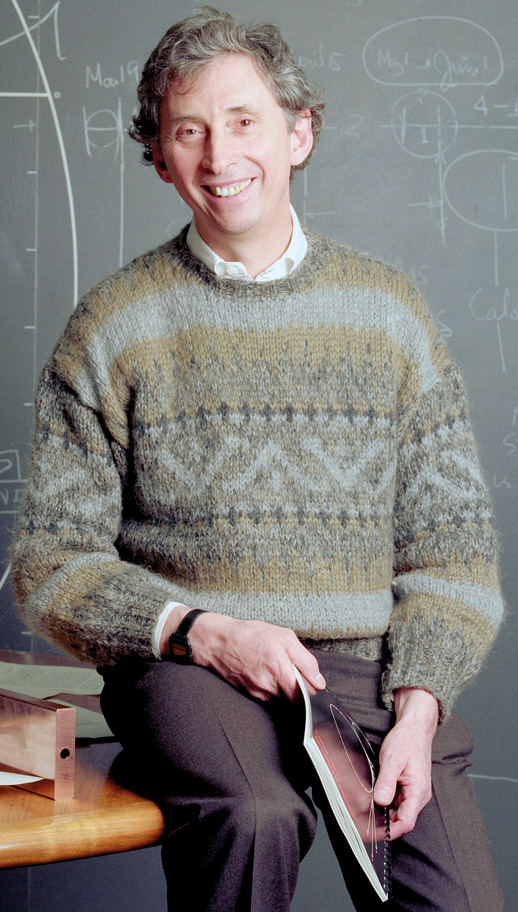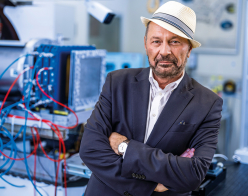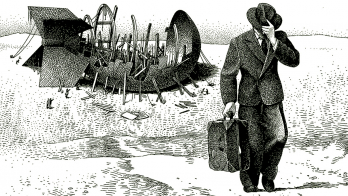
John Peoples, the third director of Fermilab, who guided the lab through one of the most critical periods in its history, passed away on 25 June 2025. Born in New York City on 22 January 1933, John received his bachelor’s degree in electrical engineering from the Carnegie Institute of Technology (now Carnegie Mellon University) in 1955. After several years at the Glen L. Martin Company, John entered Columbia University where he received his PhD in physics in 1966 for the measurement of the Michel parameter in muon decay under the direction of Allan Sachs. This was followed by a teaching and research position at Cornell University and relocation to Fermilab, initially on sabbatical, in 1971.
John officially joined the Fermilab staff in 1975 as head of the Research Division. His tenure included the discovery of the upsilon particle (b-quark bound state) by Leon Lederman’s team in 1977. He also held responsibilities for the upgrading of the experimental areas to accept beams of up to 1 TeV in anticipation of the completion of the Fermilab Tevatron.
In 1981, following Lederman’s decision to utilise the Tevatron as a proton–antiproton collider, John was appointed head of the TeV-I Project, with responsibility for the construction of the Antiproton Source and the collision hall for the CDF detector. Under John’s leadership, a novel design was developed, building on the earlier pioneering work done at CERN for antiproton accumulation based on stochastic cooling, and proton–antiproton collisions were achieved in the Tevatron four years later, in 1985.
Tireless commitment
John succeeded Lederman to become Fermilab’s third director in July 1989, shortly after the decision to locate the Superconducting Super Collider (SSC) in Waxahachie, Texas, creating immense challenges to Fermilab’s future. John guided the US community to a plan for a new accelerator, the Main Injector (and ultimately the Recycler), that could support a high-luminosity collider programme for the decade of SSC construction while simultaneously providing high-intensity extracted beams for a future neutrino programme that could sustain Fermilab well beyond the SSC’s startup. The cancellation of the SSC in 1993 was a seismic event for US and global high-energy physics, and ensured the Tevatron’s role as the highest energy collider in the world for the next almost two decades. John was asked to lead the termination phase of the SSC lab. In 1994/1995, as director of both Fermilab and the SSC, he worked on this painful task with a special emphasis on helping the many suddenly unemployed people find new career paths.
During John’s tenure as director, Fermilab produced many important physics results. In 1995, the Tevatron Collider experiments, CDF and D∅, announced the discovery of the top quark, the final quark predicted in the Standard Model of particle physics at the mass of more than 175 times that of the proton. To ensure that the experiments could analyse their data quickly and efficiently, John supported replacing costly mainframe computers with “clusters” of inexpensive microprocessors developed in industry for personal computers and later laptops and phones. The final fixed-target run with 800 GeV extracted beam in 1997 and 1998 helped resolve an important and long-standing problem in CP violation in kaon decays and discovered the tau neutrino.
His leadership both enhanced international collaboration and retained a prominent role for Fermilab in collider physics
From 1993–1997, John served as chair of the International Committee for Future Accelerators (ICFA). He stepped down after two terms as Fermilab director in 1999. In 2010, he received the Robert R. Wilson Prize for Achievement in the Physics of Particle Acceleration from the American Physical Society.
Under John’s influence, there were frequent personnel exchanges between Fermilab and CERN throughout the 1980s, as Fermilab staff benefited from CERN’s experience with antiproton production and CERN benefited from Fermilab’s experience with the operations of a superconducting accelerator. These exchanges extended into the 1990s, and following the termination of the SSC, John was instrumental in securing support for US participation in the LHC accelerator and detector projects. His leadership both enhanced international collaboration and retained a prominent role for Fermilab in collider physics after the Tevatron completed operations in 2011.
During the 1980s, astrophysics became an important contributor to our knowledge of particle physics and required more ambitious experiments with strong synergies with the latest round of HEP experiments. In 1991, John formed the Experimental Astrophysics Group at Fermilab. This led to its strong participation in the Sloan Digital Sky Survey (SDSS), the Pierre Auger Cosmic Ray Observatory, the Cryogenic Dark Matter Search (CDMS) and the Dark Energy Survey (DES), of which John became director in 2003. John’s vision of a vibrant community of particle physicists, astrophysicists and cosmologists exploring the inner space-outer space connection is now reality.
Those of us who had the privilege of knowing and working with John were challenged by his intense work ethic and by the equally intense flood of new ideas for running and improving our programmes. He was a gifted and dedicated experimental physicist, skilled in accelerator science, an expert in superconducting magnet design and technology, a superb manager, and a great recruiter and mentor of young engineers and scientists, including the authors of this article. We will miss him!








